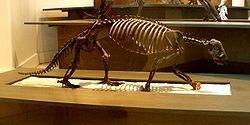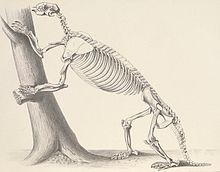
Theosodon is an extinct genus of litoptern mammal from the Early to Middle Miocene of South America.
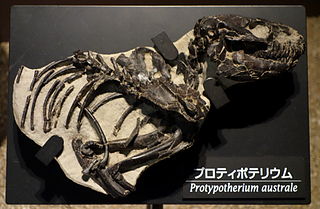
Protypotherium is an extinct genus of notoungulate mammals native to South America during the Oligocene and Miocene epochs. A number of closely related animals date back further, to the Eocene. Fossils of Protypotherium have been found in the Deseadan Fray Bentos Formation of Uruguay, Muyu Huasi and Nazareno Formations of Bolivia, Cura-Mallín and Río Frías Formations of Chile, and Santa Cruz, Salicas, Ituzaingó, Aisol, Cerro Azul, Cerro Bandera, Cerro Boleadoras, Chichinales, Sarmiento and Collón Curá Formations of Argentina.

Patagornis is a genus of extinct flightless predatory birds of the family Phorusrhacidae. Known as "terror birds", these lived in what is now Argentina during the Early and Middle Miocene; the Santa Cruz Formation in Patagonia contains numerous specimens. Patagornis was an agile, medium sized Patagornithine and was likely a pursuit predator.
Hiskatherium is an extinct genus of small ground sloth from the Middle Miocene Honda Group of Bolivia. The type species H. saintandrei was named in 2011 on the basis of a lower jaw. Although it has not been placed in a specific family, Hiskatherium is similar to the extinct sloths Hapalops and Xyophorus.

Propalaehoplophorus, also written as Propalaeohoplophorus, is an extinct genus of glyptodont, which lived in South America during the Early Miocene epoch.
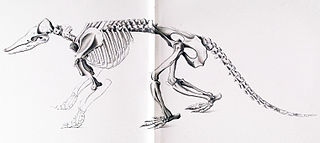
Stegotherium is an extinct genus of long-nosed armadillo, belonging to the Dasypodidae family alongside the nine-banded armadillo. It is currently the only genus recognized as a member of the tribe Stegotheriini. It lived during the Early Miocene of Patagonia and was found in Colhuehuapian rocks from the Sarmiento Formation, Santacrucian rocks from the Santa Cruz Formation, and potentially also in Colloncuran rocks from the Middle Miocene Collón Curá Formation. Its strange, almost toothless and elongated skull indicates a specialization for myrmecophagy, the eating of ants, unique among the order Cingulata, which includes pampatheres, glyptodonts and all the extant species of armadillos.

Lycopsis is an extinct genus of South American metatherian that lived during the Miocene in Argentina and Colombia.

Miocochilius is an extinct genus of small notoungulate mammals (typotheres) native to South America. The genus lived during the Middle Miocene epoch. The genus contains two described species, the type species M. anomopodus described in 1953 by Ruben Arthur Stirton and M. federicoi, described and included in the genus by Darin A. Croft.

Proschismotherium is an extinct genus of ground sloth of the family Megalonychidae, endemic to Argentina during the Early Miocene. It lived from 17.5 mya — 16.3 mya, existing for approximately 1.2 million years. The type, and only, species, P. oppositum, was named in 1902 by Florentino Ameghino based on a single specimen found in the Santacrucian-aged Colpodon Beds of Argentina. Ameghino in 1902 placed Proschismotherium in the Megatheriidae, alongside Hapaloides, which was its sister taxon.
Proterotherium is an extinct genus of litoptern mammal of the family Proterotheriidae that lived during the Late Miocene of Argentina and Chile. Fossils of this genus have been found in the Ituzaingó Formation of Argentina, and the Galera Formation of Chile.
Promacrauchenia is an extinct genus of macraucheniids that lived during the Late Miocene to Late Pliocene epochs of what is now Argentina and Bolivia. It belongs to the subfamily Macraucheniinae, which also includes Huayqueriana, Macrauchenia, and Xenorhinotherium. Fossils of this genus have been found in the Ituzaingó, Andalhuala, and Cerro Azul Formations of Argentina.
Llullataruca is an extinct genus of macraucheniid litoptern. It lived during the Middle Miocene of what is now Bolivia.
Prolicaphrium is an extinct genus of proterotheriid litoptern that lived during the Early Miocene, in what is now Argentina. Fossils have been found in the Sarmiento Formation of Argentina.
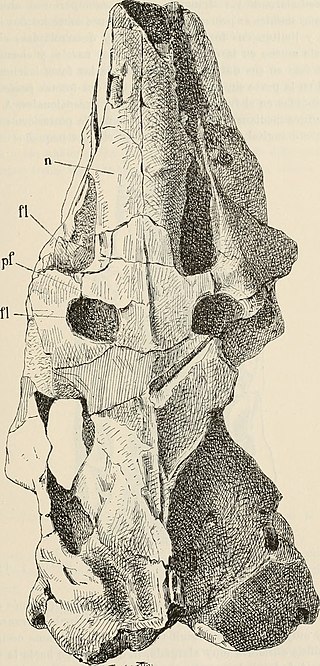
Hemihegetotherium is an extinct genus of hegetotheriid notoungulate that lived from the Middle to the Late Miocene of what is now Argentina.
Megathericulus is an extinct genus of ground sloths in the Megatheriidae family. It lived during the Middle Miocene, 11-16 Ma in what is now South America. Fossils have been found principally in Argentina, Bolivia, and Peru. It is a smaller representative of the megatheres. Despite being one of the earliest-known members of the family, its dentition structure is associated with homodont teeth belonging to the more modern line of evolution. The genus was scientifically named in 1904. Only one species is currently recognized, Megathericulus patagonicus.
Huilabradys is an extinct genus of ground sloths of the family Nothrotheriidae that lived in what is now Colombia. Huilabradys was discovered in the strata of the La Tatacoa desert in the Huila department, in the Villavieja Formation, and is part of the so-called La Venta fauna, a fossiliferous location from the mid-Miocene period that has provided a notable paleontological contribution on the Miocene faunas of northern South America. The remains discovered are basically fragments of the jaws and teeth, allowed the identification of this species, whose only species is Huilabradys magdaleniensis, and was classified as a member of the nothrotheriid subfamily Nothrotheriinae, which comprises small to medium-sized species of ground sloths.
Mesopotamocnus is an extinct genus of megalonychid ground sloth that lived during the Late Miocene in what is now Argentina. Fossils have been found in the Ituzaingó Formation of Argentina.

Perimys is an extinct genus of neoepiblemid rodent that lived from the Early to Late Miocene in what is now South America. Fossils have been found in the Cerro Bandera, Cerro Boleadoras, Ituzaingó, Santa Cruz, and Sarmiento Formations of Argentina, and the Galera, Santa Cruz and Río Frías Formations of Chile.

The Santa Cruz Formation is a geological formation in the Magallanes/Austral Basin in southern Patagonia in Argentina and in adjacent areas of Chile. It dates to the late Early Miocene epoch, and is contemporaneous with eponymous Santacrucian SALMA. The formation extends from the Andes to the Atlantic coast. In its coastal section it is divided into two members, the lower, fossil rich Estancia La Costa Member, which has a lithology predominantly consisting of tuffaceous deposits and fine grained sedimentary claystone and mudstone, and the upper fossil-poor Estancia La Angelina Member, which consists of sedimentary rock, primarily claystone, mudstone, and sandstone. The environment of deposition is interpreted to have been mostly fluvial, with the lowermost part of the Estancia La Costa Member being transitional between fluvial and marine conditions. The environment of the Estancia La Costa Member is thought to have been relatively warm and humid, but likely became somewhat cooler and drier towards the end of the sequence. The Santa Cruz Formation is known for its abundance of South American native ungulates, as well as an abundance of rodents, xenarthrans, and metatherians.

Ortotherium is a genus of megalonychid ground sloth from the Late Miocene Ituzaingó Formation of Entre Rios Province, Argentina. Although many species were described, the only valid species of the genus is Ortotherium laticurvatum, with many species being junior synonyms. Ortotherium is known from very fragmentary material, all of which is material from the mandible and teeth. The holotype of O. laticurvatum consists of an incomplete left dentary that had been unearthed from a series of sediments known as ‘Conglomerado osifero’ in Paraná, Argentina. Argentina paleontologist Florentino Ameghino named the species in 1885, though he would go on to name four more, invalid, species of the genus. One species however, O. brevirostrum, has been reclassified as Mesopotamocnus.
